|
Roy Keeley, Salt Lake City Tribune, June 1, 1936 (Source: newspapers.com)
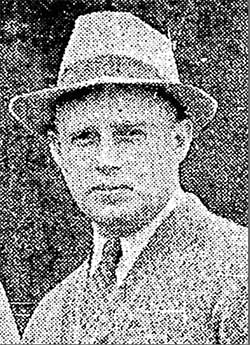 |
Roy Keeley was signed in the Floyd Bennett Field Register on an unidentified date. He flew the Bellanca D Skyrocket he identified as NS3 (S/N 638). The "NS" registration identified the airplane as belonging to the U.S. Department of Commerce (DOC). The photograph, right, is from the Salt Lake City Tribune, June 1, 1936. Keeley worked for the DOC at that time (see below).
The 1930 U.S. Census identified Keeley as single at age 31 living at 703 Middleboro Avenue in Taunton, MA as a boarder in the household of Henry E. King. His occupation was coded as "Pilot" in the "Transportation" industry. The Middleboro Avenue address today is a large, two-storey colonial home. It could be an upgraded 1930s construction.
Interestingly, his Middleboro Avenue address showed up on a firearm carry permit issued to Keeley on September 24, 1930. Below is a photograph of that permit, courtesy of a site visitor.
Firearm Carry Permit Issued to R.B. Keeley, September 24, 1930 (Source: Site Visitor)
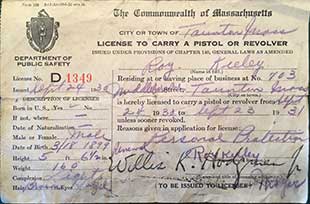 |
Colt Automatic Pistol Owned by R.B. Keeley, Ca. 1930 (Source: Site Visitor)
 |
Permitted firearm was a Colt .38 hammerless automatic pistol manufactured in 1926. A photograph of that pistol, still in its original box, is below. I have no information regarding Keeley's need to carry a firearm. Perhaps his job as a pilot involved valuable cargo or vulnerable passengers.
He did state "Personal Protection" on his permit, so perhaps his work as a DOC officer involved interception of bootleggers (the end of Prohibition by ratification of the 21st Amendment repealing the 18th Amendment didn't take place until December 5, 1933). To continue, importantly, the Middleboro Avenue address sits in juxtaposition to the current Taunton Municipal Airport, AKA King Field. A contemporary aerial view of King Field from Google Earth is below.
Earlier, Henry King owned and developed the property that became the Taunton airport, originally opened in 1919. The Keeley-King Corporation operated the field during its early years. As of February 15, 1935, the Keeley-King Aircraft Corporation was dissolved by "Chap. 0008 An Act Dissolving Certain Corporations," promulgated by the Commonwealth of Massachusetts. They were among hundreds of other corporations listed as dissolved by the same act. The Great Depression was very harsh on businesses in the Commonwealth.
Note the position of the Middleboro Avenue home, upper left, and the access road directly to the airport. Near the house is what appears to be the remains of an older runway.
Taunton Municipal Airport, King Field, 2016 (Source: Google Earth)
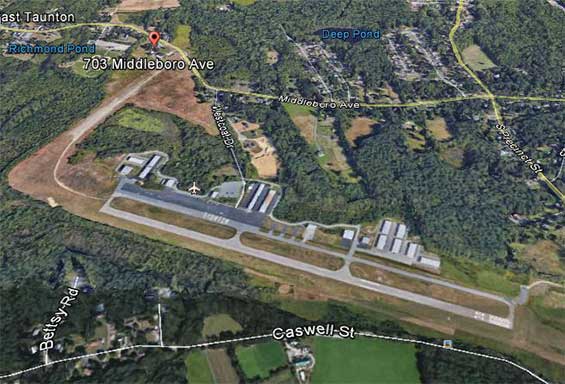 |
Keeley must have married soon after the 1930 Census, because the 1932-1935 city directories for Taunton, MA listed him living with wife Elizabeth M. (or C.) at 703 Middleboro Avenue. His occupation was cited as secretary and general manager of Keeley-King Aircraft Corporation. The company was owned by his brother, Joseph A. Keeley and Henry E. King. Organized in 1928 (Shamokin News-Dispatch [PA], August 24, 1928) and capitalized at $100,000, they were aircraft manufacturers.
Air Commerce Bulletin, August 15, 1934, Page 190 (Source: Woodling)
 |
Through the rest of the 1930s and into the early 1940s, Keeley traveled numerous times to the Caribbean and South America. On March 2, 1935 a U.S. Immigration Service form recorded his departure from Miami, FL to San Juan, PR aboard the Sikorsky S-42 NC822M (not a Register airplane). He was traveling without Elizabeth. Likewise, a similar form reported his arrival from Barranquilla, Colombia at Miami on NC81V, a Sikorsky S-40, S/N 2001, operated by Pan American Airways. The year was 1935, but the exact date was not cited. The link shows the S-40 in still and motion sequences.
An article from the Air Commerce Bulletin, August 15, 1934, Page 190, right, identifies Keeley's DOC appointment to South America. His flights to San Juan and Colombia were undoubtedly on behalf of official DOC business as discussed in the article.
Near the same time, during the six months prior to June, 1935, Keeley was tasked with aerial search and rescue for a fellow DOC pilot and airplane that had crashed six months earlier. The article, below, from the Salt Lake City Tribune, June 1, 1936, described his work.
Salt Lake City Tribune, June 1, 1936 (Source: newspapers.com)
 |
The search was for fellow DOC pilot Howard Stark and his airplane, the Stinson R-2 NS40 (S/N 8512), shown in the photograph. Howard Stark was a significant name, in that he was probably the earliest pilot to master instrument flight using just the "steam gages" that equipped regular Golden Age aircraft. Others credited with instrument flight firsts, like Jimmy Doolittle and Albert Hegenberger, came after, using radio aids. Given his quiet, behind the scenes work, it's probably worth a few words to feature Stark and his contributions to aviation, which have import even today. I've done so a few paragaphs below.
On January 6, 1940 Keeley was documented on an immigration form returning to the U.S. from Charlotte Amalie, St. Thomas, V.I. in the Beech 18B NC18569, S/N 163. And on August 23, 1940, he traveled from Belem, Brazil to Miami on the Boeing S-307 NC19910 operated by Pan American. The link shows you the 307 in still and motion footage.
There are other flights, from Haiti, Cuba, et al. These were frequent enough that I am not sure if he was the pilot of any of them, which would have suggested that he worked for Pan Am, Caribbean Atlantic Airlines or other air carriers. However, as above, he could have been flying on official DOC business. If you have any insight as to the purpose of these many flights, please let me KNOW.
The 1940 Census placed Keeley at age 40 living at 710 Mercer Street, College Park, GA. He lived with Elizabeth (31), son Roy, Jr. (6) and daughter Frances (9-months). They owned their home, which was valued at $2,500. His occupation was coded as "Airline Inspector" for the "Civil Aeronautics Authority" (CAA). His salary was coded as $4,600, a decent wage in 1940. The 1940 Census stated that he had four years of college, and listed his residence in 1935 as New Port Richey, FL.
College Park was, and still is, a suburb of Atlanta, juxtaposed with what is now called the Hartsfield-Jackson Atlanta International Airport. In 1940, however, when Keeley was there, it was called Candler Field. Candler Field namesake and airplane owner Asa Candler is cited and discussed at the link.
The 1941 Atlanta city directory corroborated his residence there. However, he appeared to change jobs, because the 1942 and 1946 city directories for Mobile, AL listed them living there. In 1942, he was listed as the vice president of the Waterman Airlines, Inc. in Mobile. No mention was made of his CAA duties.
But, the Fairbanks Daily News-Miner (AK), October 7, 1957, placed Keeley in Fairbanks accompanying the CAA administrator during an appearance there in support of Fairbanks International Airport's desire to lengthen its runway and incorporate other improvements. Keeley was identified at that time as director of flight operations and airworthiness for the CAA. I have no other information regarding his life. If you can help fill in the blanks, please let me KNOW.
From the carry permit at the top of the page, Keeley was born March 18, 1899. He flew West on June 29, 1973 from Dunedin, FL, age 74. Born in 1908, Elizabeth passed away in 1996.
---o0o---
HOWARD STARK
Howard Stark did not sign any Registers. The first time I heard mention of Stark was during a conversation I had with Register pilot John Miller in 2002. Miller was good friends with Stark and identified him as a pioneer in instrument flight. He related to me Stark's experiences flying mail during the late 1920s from New Jersey to Boston, MA. John devoted a chapter to Stark and his 1-2-3 system of instrument flight. That chapter begins on page 9 of this REFERENCE.
Salt Lake Tribune (UT), March 11, 1936 (Source: newspapers.com)
 |
In 1931, Stark published Blind or Instrument Flying?." A PDF download (2.4mB) of his 30-page book is at the link (courtesy of the National Air & Space Museum). Stark's book provided a brief biography. He described in detail, illustrated with instrument diagrams, his 1-2-3 system of maintaining aircraft stability, control and coodination without horizontal reference outside the cockpit. Notable was the cavalier way he discussed flying in thunderstorms. If you are a contemporary pilot, you were taught better.
Salt Lake Tribune (UT), April 23, 1936 (Source: newspapers.com)
 |
He explained how to control an airplane using just the three simple instruments commonly available in Golden Age aircraft, (1) the turn indicator (stabilized with rudder), (2) the bank indicator (stabilized with ailerons) and (3) the vertical speed (climb) indicator (stabilized with elevator).
According to Stark's method, upon entering the clouds, with no view of the ground or horizon, these instruments were scanned 1-2-3 and coordinated with the flight controls. If they were coordinated correctly, the aircraft maintained level flight. Turns were affected by consulting the compass and then consulting the respective instruments to begin and end the turn. This took a great amount of concentration by the pilot, but it is still basically the way airplanes are controlled by hand today under instrument conditions. The instruments are a bit more refined, but the principle is the same. Autopilots made life much easier under instrument conditions. But they fail, and the fall-back is still the basic instruments.
After his crash in January, 1936, great effort was spent to find Stark. Winter weather hampered attempts during the first few months. It was soon assumed that he had succumbed to cold and exposure on the slopes of the blizzard-swept Wasatch range. Regardless, an expert DOC pilot, Lloyd Juelson (not a Register pilot) was brought in to continue the search, "until further notice." His assignment was reported in the Salt Lake Tribune (UT), March 11, 1936, above, left.
Similarly, an Army bomber was assigned to the area on April 23, 1936 to aid in the search as reported in the Salt Lake Tribune (UT), April 23, 1936, right. Register pilot Henry Clagett assigned the bomber. Roy Keeley was assigned to be in charge of the bomber search itinerary. This article misidentified Stark's airplane as a "monocoupe."
Stark's Stinson was not found until May, as reported in the Ogden Standard (UT), May 31, 1936, below. It had flipped over, as shown in the Salt Lake City Tribune, June 1, 1936, above, but had received little damage.
Ogden Standard (UT), May 31, 1936 (Source: newspapers.com)
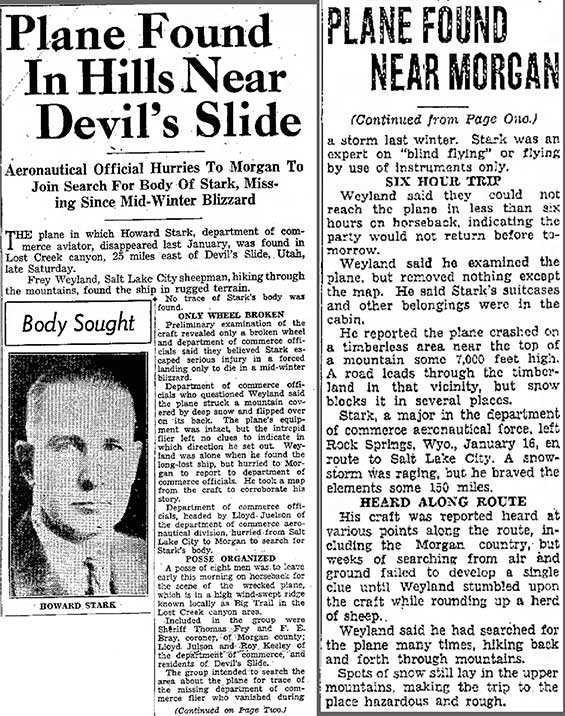 |
The Ogden Standard, September 21, 1939, below, reported the discovery of Stark's body by a sheepherder about six miles from his airplane.
Ogden Standard, September 21, 1939 (Source: newspapers.com)
 |
The Salt Lake Tribune (UT), September 21, 1939 also reported the discovery, below, providing also a map.
Salt Lake Tribune (UT), September 21, 1939 (Source: newspapers.com)
 |
A tribute to Stark appeared in the Harrisburg Telegraph (PA), September 22, 1939, below. It appears to be an editorial. I could not identify "AHS."
Harrisburg Telegraph (PA), September 22, 1939 (Source: newspapers.com)
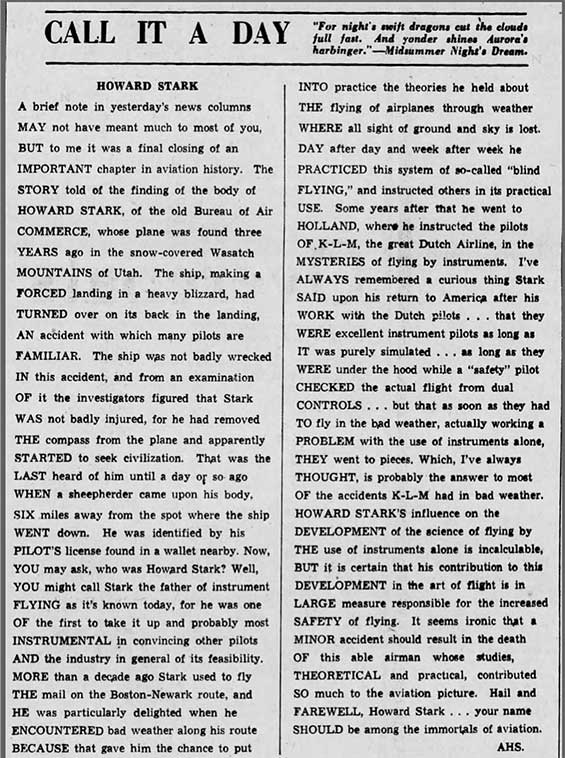 |
---o0o---
THIS PAGE UPLOADED: 03/01/17 REVISED: 03/07/17, 08/16/17
|













